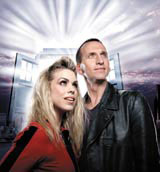Get caught up in the Web
While websites are still mainly information-based, Trish Lorenz looks at how an interactive Web presence will be integral to programme-making in the future

With a whir of lights and narrowly avoiding some flying Daleks, Dr Who and his Tardis returned to our TV screens last Saturday. The souped-up special effects are a welcome change, but the series has another first to offer.
Over two hours of specially shot programmes (even the Daleks have a video diary) and the entire BBC 3 ‘Making Of…’ will be available on-demand on the Web – the first time a non-news TV show has been streamed in this way by the BBC.
The commitment to a Web presence doesn’t end there. User interaction is firmly on the agenda and the site includes the BBC’s first multi-player on-line game, hidden sites that are referenced in the show, along with MP3 music downloads and clips from original 1960s and 1970s programmes. What’s noteworthy is not so much the activity itself as the rarity of such an approach in the broadcast medium. Take a look at most broadcasters’ websites and you’ll find they go no further than fact sheets and text-based interviews.
There is little emphasis on interaction or dialogue and few opportunities to engage loyal viewers, and designers believe broadcasters are missing an opportunity. According to All of Us partner Nick Cristea, the problem is that most still perceive the Web as primarily a vehicle for programme support.
‘It’s a one-way relationship‚’ he maintains. ‘A show is produced and the website is used for additional information. Broadcasters could go a lot further in delivering more engaging and enriching content. At the moment, the glamorous stuff is all on TV and [the Web] is seen as more suited to print material like fact sheets and recipes.’
Digit creative director Daljit Singh agrees. ‘Because broadcasters are programme-focused, Web content tends to be an afterthought, not an integral part of the process. It is starting to change, but sites are primarily still information-based‚’ he says. BBC Online senior content producer James Goss is responsible for the design of the Dr Who website, www.bbc.co.uk/doctorwho. He admits its creation was ‘very different from most BBC websites’. ‘Dr Who was unusual – we usually get a call two weeks before the programme goes out and we don’t have that much contact between Web and TV. With Dr Who we were talking to them as soon as it was commissioned‚’ he says.
But, he points out, ‘This is the first site we’ve done in the broadband era‚ and that’s meant the team was able to commission programming just for the Web’. For many years the practical constraints of technology limited what was possible, but the rapid growth of broadband has opened up a number of significant opportunities.
Giving viewers control of content is becoming possible. All of Us is working on a project for a television client that will see the broadcaster make its archive of films available on the Internet before the end of the year. In the US, many long-running programmes already offer viewers the chance to download on-line episodes they have missed.
‘Massive archives of content will become available very soon and viewer expectations of [both TV and the Internet] will change,’ predicts Cristea.
Singh believes building on-line communities is another opportunity broadcasters have so far overlooked. The group worked with MTV2 to create a website where viewers select and submit ten of their favourite tracks, after which the broadcaster e-mails them to let them know when their ‘programme’ will screen on TV. ‘It became a channel built by people and created a big community of viewers,’ says Singh.
As wireless homes become a reality, linking the two mediums on a live basis is also an option. The Formula 1 site, www.formula1. com, with its live telemetry system, gives viewers access to the same pit information that the race teams see, and committed fans will flick between the two mediums during race broadcast.
Dunning Eley Jones partner Liz Dunning believes broadcasters are waking up to the fact that the Internet offers real benefits. The group worked with Teachers’ TV, which today offers Internet streaming of all programmes on its website (designed by Victoria Real).
Living TV is another of Dunning Eley Jones’ clients. Its food channel offers recipes on-line, but viewers can also click on a video button to see the recipe being made.
‘Smaller channels, in particular, focus on a strong Web proposition to strengthen and deepen the relationship with the viewer,’ says Dunning. But to make the most of the Internet’s potential, broadcasters need to invest in creativity, not just technical know-how, says Cristea.
‘Internet content can’t be an afterthought. It needs to be taken seriously, an investment as part of the programme budget. Broadcasters must consider Web requirements upfront, before they begin filming, so special content can be produced,’ he maintains.
Singh believes involving specialists from the world of gaming and animation is important. ‘Creatively we need to see more convergence,’ he explains. ‘Integration is still fairly lacklustre. We need to see more people who understand storytelling and gaming getting involved.’ All agree distinctions between the two channels will narrow in the future.
‘Broadcasters need to stop worrying “Is it TV or Web?” and think about the programme and the audience,’ maintains Cristea. ‘The Internet is just a different delivery mechanism, not a different medium.’ Perhaps the Dr Who site will have a dramatic impact on programme-makers‚ expectations and use of the Web. The challenge for designers lies in motivating broadcasters to move Web content out of the wings and into the limelight.
-
Post a comment



